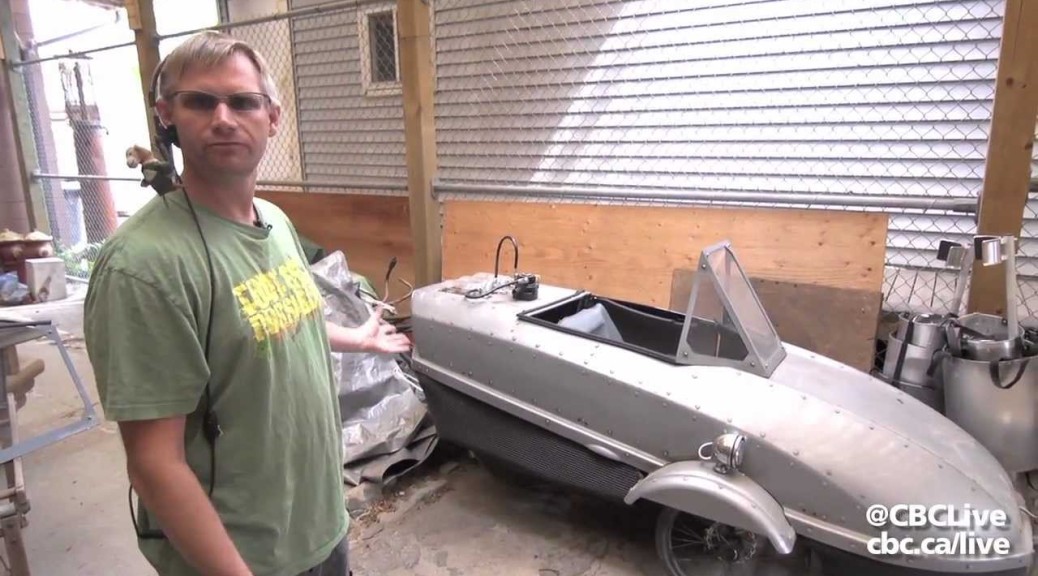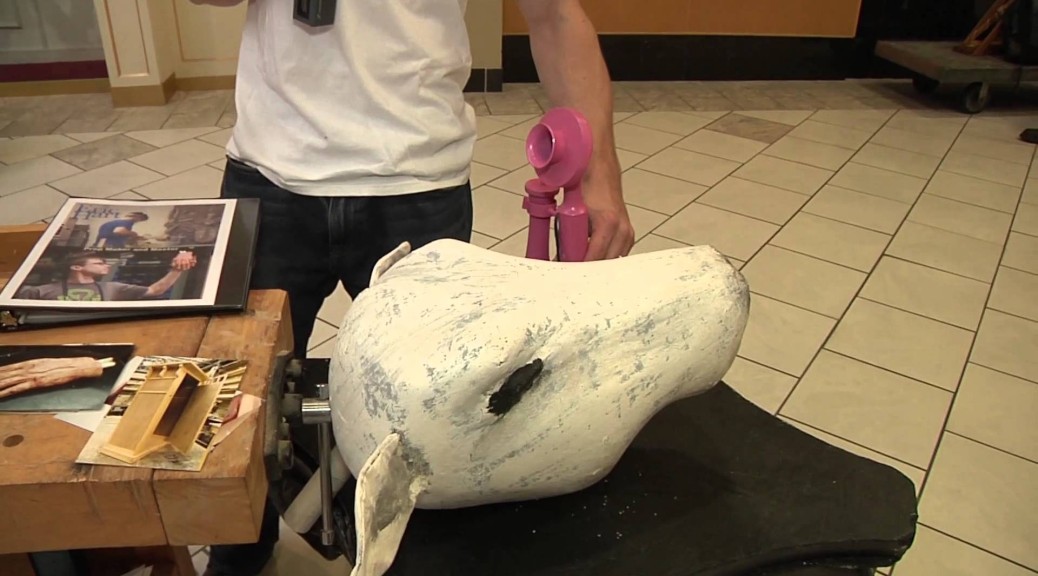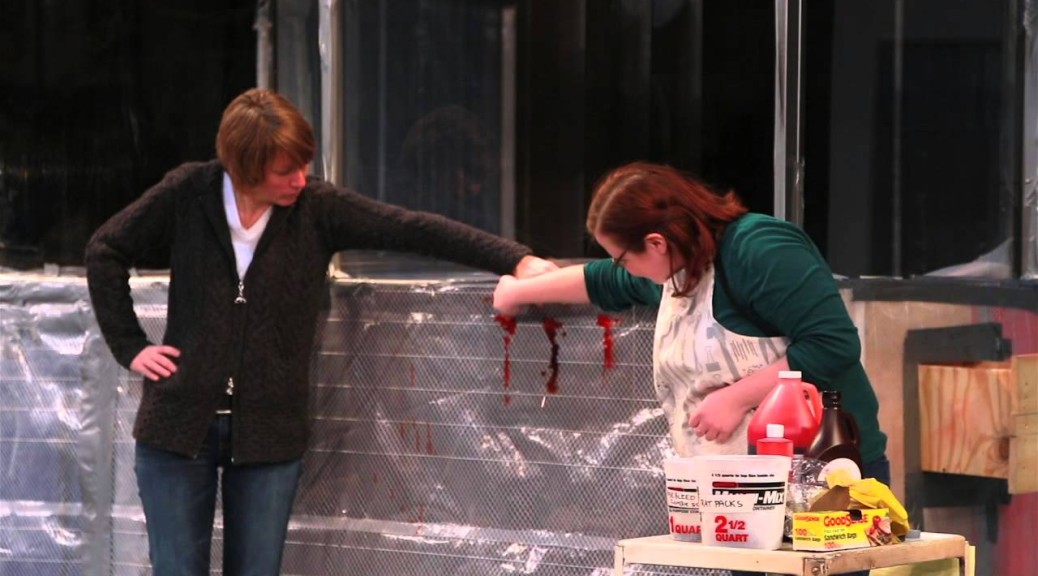I’ve come across the following lists of duties and responsibilities for various members of the props department in a number of places. These are the IATSE job classifications for union members working in film. I have noticed some theatres will use these as starting points to develop their own job descriptions for people in the props department as well. Property Master The duties of the Property Master shall include preparation of a hand prop breakdown, with scene allocations as per the shooting script; to research the historical period of said administered hand props; to prepare, build and procure props to be seen on camera; the repair and return of props to original condition and source; arranging for all necessary permits to convey restricted weapons; co-ordinate with the Wardrobe Department the required accessories; while on set, the Prop Master will administer props to artists, strike and reset hot sets established by the Set Decorators, with the aid of Polaroid’s, photographs or sketches; consult with the Script Supervisor on the continuity of hand props; responsible for the disbursement of the assigned budget; and delegate the work required for the efficient operation of the Department. Assistant Property Master Duties are acts as the Prop Master’s representative on the set; during pre-production helps with script and prop breakdown; in the Prop Master’s absence this person can be left in charge of the props on shooting set; makes sure that the set and props are as the Props Master wishes them to be; oversees the supplying and loading of the truck; has the ability to oversee the set and props in a camera ready condition; has the ability to oversee the set and prop continuity; and can perform these duties in an unsupervised role. Additionally, this person must hold a valid Firearms Acquisition Certificate; carry the Motion Picture Firearms Safety Course card; be knowledgeable in the building and repair of props; be knowledgeable in the handling of firearms; the safe use of firearms and the blank firing of firearms; and carries the same responsibilities for the safety of artists and shooting crew when it comes to the firing of blanks as the Props Master. Props Buyer Performs those duties as delegated by the Property Master. Armour Must have Fire Arms Acquisition Certificate and no criminal record. Responsible for maintaining safety on set in relation to weapons and ammunition, including but not limited to determining the distance for all loads; ¼, ½ and full loads and as such providing plexi-glass shields, etc. when required. Order all weapons, permits, ammunition etc. and inspect them as a safety precaution. Responsible for the distribution and collection of the weapons to talent and background performers. Warn to the cast and crew prior to firing weapons, secure area effected. Along with performing those duties as delegated by the Property Master. Props Builder Work with wood, leather, and metal must have carpentry skills, and perform duties as delegated by the Property Master. Props Assistant Performs those duties as delegated by the Property Master. Props Men/Women or Props Crew Performs those duties as delegated by the Property Master
Tag Archives: prop master
Props from “The Murdoch Mysteries”
My Canadian readers may recognize some of the props from the following video; in it, CBC Live gets a tour of some of the props from The Murdoch Mysteries by prop master Craig Grant. We get a look at a dissected rat, an early airplane and an electric car. Great fun!
Props from “You Can’t Take it With You”, 1937
The following article, by Eugene Kinkead and Russell Maloney, first appeared in The New Yorker in 1937:
“You Can’t Take it With You,” Moss Hart’s and George Kaufman’s play about that mad Morningside Heights family, the Sycamores, recently established a theatrical record by putting seats on sale eighteen weeks in advance. Also, it probably holds some kind of record for the number and complexity of its props; all in all, there are about seven hundred props, requiring the attention of three property men instead of the customary one. “We have more props than ‘White Horse Inn,'” the head prop man, Al Burkhardt, told us when we went backstage to investigate. As we probably need not tell you, the play has only one set, which represents the living room of the Sycamores’ apartment. First thing you notice is the magazines scattered here and there in corners. There are about three hundred and fifty of them—1929 Navy-Princeton football programs, and back numbers of Review of Reviews, Magazine of Wall Street, New York Masonic Outlook, and other conservative publications; nothing exciting, like The New Yorker, because that might distract from the actors.
The three snakes in a solarium are mechanical ones; Al Burkhardt works them from backstage, by means of a lever. The flies, brought on in a bottle to be fed to the snakes, used to be fishing flies from Davega’s; now, for some reason, they’re raisins. The letters scattered about, some of which Grandpop reads aloud, are mostly letters from hotels, soliciting the patronage of the “Of Thee I Sing” company when it was going on tour. The wastepaper basket is filled mostly with crumpled-up jottings made by Mr. Kaufman during rehearsal. We fished out one of the sheets, and found it covered with vague but stimulating phrases: “Stamp scene messy—Penny’s red beret—You, too, can take the pimples off your face—He will get them yet if they do not get him—go right into pirouette.” The fern in the bay window of the set is a fake. The cornflakes are real. Among the “atmosphere props” (things that aren’t handled) are a Filipino fly whip, a key to the City of Buffalo, a hundred-year-old string of wampum, a palette left behind by Donald Oenslager (who designed the set), a tusk of ivory, and a real hand-carved African war shield. The ship model that hangs from the ceiling cost $100, but this is offset by Mr. Oenslager’s good luck in picking up, for a song, a print that turned out to be a Piranesi, worth $150. If there’s anything left of it by the time the play closes. The two kittens who appear in the first act come from the Medor Kennels; they are brought and called for every night by a man named Samuel. They have to be replaced every two weeks, because they have to be small kittens.
One of the hardest things to acquire was a Meccano model of a ship, called Queen Mary in the play. Originally, they had a model of the Empire State Building, with the line “I christen thee ‘Empire State,’ and I wouldn’t be in your shoes for anything.” The present gag, with the ship, is “This is the Queen Mary.” “No. She hasn’t got the right hat on.” Well, the stagehand who was assigned the job of finding a Meccano Queen Mary scoured New York for a week, without success. Finally he thought of telegraphing the Meccanno factory at New Haven, and they sent him just what he wanted. He rushed up to Mr. Kaufman at rehearsal with the thing, and said, “L-look, M-mr. K-k-kaufman.” (We forgot to tell you he stuttered.) Unable to get any further with that sentence, he pointed at the model and said, “F-from, f-from N-new Haven.” “Did you run all the way?” asked Mr. Kaufman.
Originally published in The New Yorker, February 13, 1937, written by Eugene Kinkead and Russell Maloney.
Friday Links on Display
It’s another Friday, and another September. This always seems like the busiest time of the year for the whole entertainment industry. Some of you may have gotten a four-day week this past week, but for most of us, it was an eight-day week. So take a seat, relax, and enjoy these links for a few minutes:
Huffington Post has an interview with props master Peter Bankins. Bankins has been a prop master in film for the past 25 years, working on movies such as Young Guns, Grumpier Old Men, Erin Brockovitch and many more.
On the other side of the pond, Farfetch has a short photo essay called “Our Day With Thomas Petherick“. Petherick is a young prop maker and set designer working mainly on fashion photography shoots.
Bill Doran and his wife created a fairly detailed set of armor and weapons from the video game Skyrim for this year’s Dragon Con. He details the lengthy build process as they fashion parts out of wood, EVA foam, Worbla, resin and more.
Finally, here is a familiar face; I was displaying some of my props at last month’s Burlington Mini Maker Faire. Coffey Productions was going around filming the various exhibits, and shot this video of me talking about my props and my book. Check it out!
Links for a Taxing Weekend
You have only a little more than two weeks left to enter my Prop Building Guidebook Contest! Don’t wait until the last minute to enter. I also wanted to point out that a week from Monday (April 22nd), you can start voting for your favorite prop in the contest; tell your friends they can vote for your prop once per day until the contest ends on April 30th. In addition to winners in each of the individual categories, the prop with the most votes will win its own prize category, so vote early and vote often! And now, onto the links.
Here is a fantastic article about the guys at Spectral Motion, one of Hollywood’s finest creature shops. They’re responsible for most of the monsters in the Hellboy films, as well as for work in X-Men: Last Stand, Blade:Trinity, and this summer’s Pacific Rim. The article is replete with information about how they got started, what kind of work they do, and what inspires them. It is also heavily illustrated with photographs showing their workshop and the inner workings of some of their creatures. I especially love the following quote about why practical effects are still necessary in an era of digital mimicry:
“A lot of times people turn to digital solutions. That’s also good, if the application is correct. But, you know, a lot of directors that we talk to are of the mind that a practical effect is far better for exactly that reason–because the actor does have a co-actor to work with, to play off of, and to have feelings about.”
I came across this short interview with Mickey Pugh, prop master on films such as Saving Private Ryan and Last of the Mohicans.
From the prop masters email list this week comes Click Americana, an ongoing collection of vintage photos and ephemera from all decades of American history. You can search for specific topics or just browse through by decade, from the 1820s to the 1980s. It has a whole section dedicated to recipes, too, great for when you need to provide period food.
And finally, if you missed my Tweet this week, I shared this video looking at the blood effects in Trinity Rep’s Social Creatures, a “zombie” play now running. Production director Laura Smith and assistant props master Natalie Kearns show us how they make the blood and organs squirt and fly.



